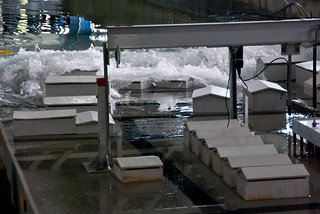Japan’s nuclear disaster released hundreds of millions of gallons of radioactive water in 2011, sparking rampant speculation that a contaminated plume would reach the waters of North America’s West Coast.
Three years later, such speculation is alive and well on the Internet. But scientists in Oregon and California have collected samples of tuna, a fish known to migrate back and forth across the Pacific, analyzed them for radioactive isotopes, Cesium-134 in particular, from Fukushima – and found levels so low they are barely detectable.
 Delvan Neville, a PhD candidate in Radiation Health Physics at Oregon State University, has tested dozens of samples of albacore tuna for radioactivity. The U.S. Food and Drug Administration’s intervention levels for cesium 134 and cesium 137 is 1200 becquerels per kilogram. The highest levels he’s seen in his albacore, of both cesium 134 and cesium 137 combined, is 1 becquerel per kilogram – a level so low that his device couldn’t pick it up until he concentrated the samples.
Delvan Neville, a PhD candidate in Radiation Health Physics at Oregon State University, has tested dozens of samples of albacore tuna for radioactivity. The U.S. Food and Drug Administration’s intervention levels for cesium 134 and cesium 137 is 1200 becquerels per kilogram. The highest levels he’s seen in his albacore, of both cesium 134 and cesium 137 combined, is 1 becquerel per kilogram – a level so low that his device couldn’t pick it up until he concentrated the samples.
“That’s more than 1,000 times lower than the point where the FDA would even think about whether they need to let people eat that food still,” he said.
Neville, along with OSU fisheries graduate Jason Phillips, is working with Dr. Lorenzo Cianelli, a marine biologist with OSU’s College of Earth, Ocean and Atmospheric Sciences , to learn more about the migration patterns of Pacific albacore. Their initial work was funded in part by Oregon Sea Grant and NOAA.
It was only the timing of their research – coinciding with the 2011 Tohoku earthquake and subsequent nuclear disaster – that led the scientists to consider radiation as a possible marker for learning which waters fish caught off the US Pacific coast might have traveled.
Learn more
- Read – or listen to – the full story from Oregon Public Broadcasting’s Earthfix program
- Read our 2012 OSU news release about the study’s early findings






